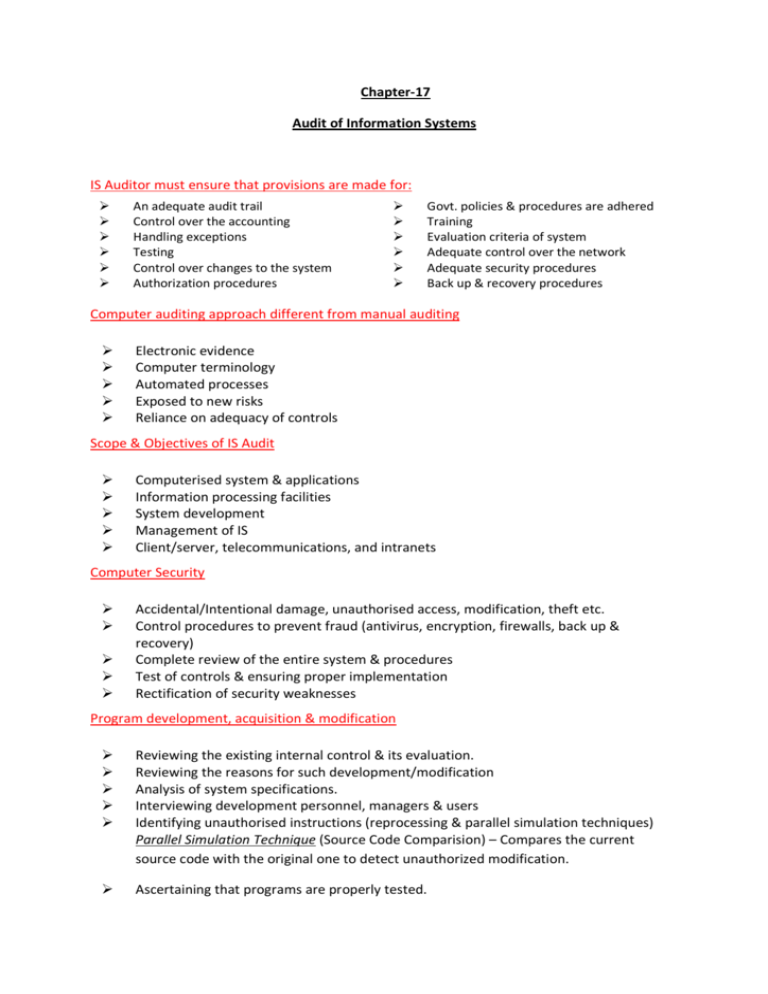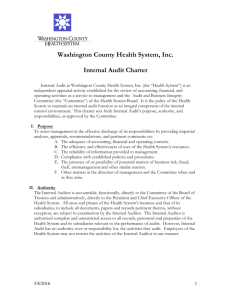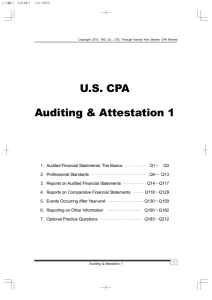Chapter-17 Audit of Information Systems IS Auditor must ensure
advertisement

Chapter-17 Audit of Information Systems IS Auditor must ensure that provisions are made for: An adequate audit trail Control over the accounting Handling exceptions Testing Control over changes to the system Authorization procedures Govt. policies & procedures are adhered Training Evaluation criteria of system Adequate control over the network Adequate security procedures Back up & recovery procedures Computer auditing approach different from manual auditing Electronic evidence Computer terminology Automated processes Exposed to new risks Reliance on adequacy of controls Scope & Objectives of IS Audit Computerised system & applications Information processing facilities System development Management of IS Client/server, telecommunications, and intranets Computer Security Accidental/Intentional damage, unauthorised access, modification, theft etc. Control procedures to prevent fraud (antivirus, encryption, firewalls, back up & recovery) Complete review of the entire system & procedures Test of controls & ensuring proper implementation Rectification of security weaknesses Program development, acquisition & modification Reviewing the existing internal control & its evaluation. Reviewing the reasons for such development/modification Analysis of system specifications. Interviewing development personnel, managers & users Identifying unauthorised instructions (reprocessing & parallel simulation techniques) Parallel Simulation Technique (Source Code Comparision) – Compares the current source code with the original one to detect unauthorized modification. Ascertaining that programs are properly tested. Thorough review of all the documentation Audit of Computer processing Understand & evaluate the processing controls. Ensure that they are practically followed Periodical review of all the controls Elimination of control deficiencies. Test data processing – Processes a series of correct & incorrect data and reverse the effect of test data after auditing. Concurrent Audit Techniques (Continuous monitoring of system and input on a real time basis) 1. Integrated test facility (fictitious records) – No need to reverse the test transactions & the user is unaware of this process of testing. 2. Snapshot Technique – Snapshot data is stored in a separate file & is reviewed by auditor 3. System control audit review file (SCARF) – Collects data of special transactions e.g. exceeding certain amount. 4. Audit hooks – Flag suspicious transactions & display a message at the auditor’s terminal 5. Continuous and Intermittent Simulation – This audit module works along with the DBMS like SCARF. It does parallel simulation & reports the discrepancy through a separate log file. Analysis of Program logic (Time consuming & require programming language proficiency) 1. Automated flowcharting programs (Automatically generates flow-chart from source code) 2. Automated decision table programs Source Data Controls Detection of inaccurate & unauthorised source data. Input control matrix (control applied to each field of input data) Periodical review of control procedures to maintain effectiveness Data Files Controls Data storage risk (access, modification, destruction) Audit procedures checklist











